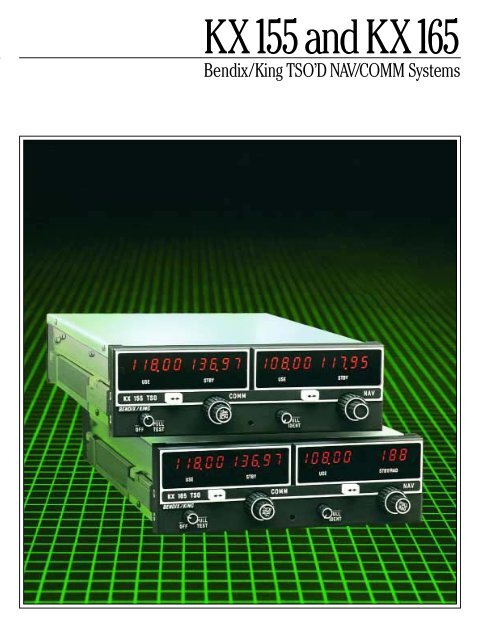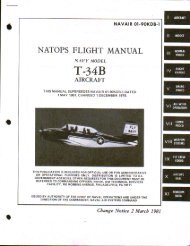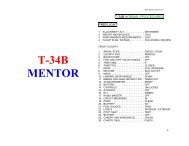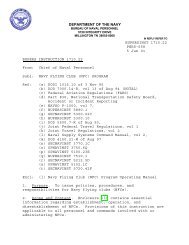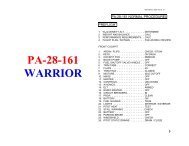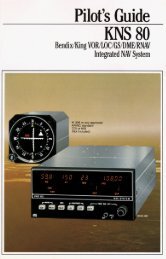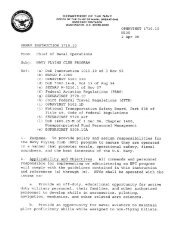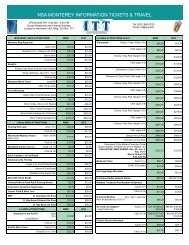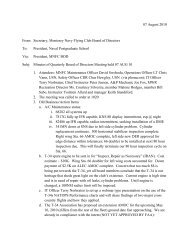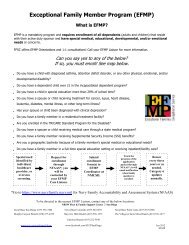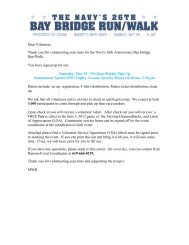KX 155 and KX 165 - NavyLifeSW.com
KX 155 and KX 165 - NavyLifeSW.com
KX 155 and KX 165 - NavyLifeSW.com
Create successful ePaper yourself
Turn your PDF publications into a flip-book with our unique Google optimized e-Paper software.
<strong>KX</strong><strong>155</strong> <strong>and</strong> <strong>KX</strong><strong>165</strong><br />
Bendix/King TSO’D NAV/COMM Systems
Innovative‘‘flip-flop’’digital displays bring you push<br />
button frequency preselection for both NAV <strong>and</strong> COMM.<br />
Photocell<br />
for automatic<br />
dimming of<br />
all readouts.<br />
It always pays to plan ahead. And<br />
with the Bendix/King <strong>KX</strong> <strong>155</strong> <strong>and</strong><br />
<strong>KX</strong> <strong>165</strong> NAV/COMMs, “stay ahead”<br />
frequency pre-planning is push button<br />
simple.<br />
Both NAV <strong>and</strong> COMM frequency<br />
displays on these units incorporate<br />
the popular “flip-flop” preselect feature.<br />
So, you can set up en route or<br />
approach frequency changeovers well<br />
in advance of your actual transition<br />
point or ATC h<strong>and</strong>off sequence for<br />
true “stay ahead” flight management.<br />
Just select your up<strong>com</strong>ing NAV<br />
or COMM frequency in the “st<strong>and</strong>by”<br />
(STBY) display, <strong>and</strong> you’re all set to<br />
“flip-flop” it into “active” status at the<br />
press of a button. This function may<br />
also be controlled from an optional<br />
remote mounted switch.<br />
Both “active” <strong>and</strong> “st<strong>and</strong>by” frequencies<br />
are displayed simultaneous-<br />
ON/OFF/VOL<br />
Control switch<br />
(Pull out<br />
for TEST;<br />
push in<br />
for automatic<br />
squelch.<br />
COMM frequency<br />
transfer button<br />
ly, so you never have to worry about<br />
what’s being stored. And there’s<br />
no chance of inadvertently erasing<br />
a frequency just when you need<br />
it most.<br />
An innovative non-volative memory<br />
circuit holds all the displayed frequencies<br />
in storage—through aircraft<br />
shutdowns or momentary power<br />
interruptions—without the need for<br />
battery power of any kind.<br />
Large, self-dimming, microprocessor-controlled<br />
gas discharge readouts<br />
<strong>and</strong> solid-state electronic tuning<br />
provide fast, accurate selection of all<br />
200 NAV <strong>and</strong> 760 COMM frequencies —<br />
<strong>and</strong> both the <strong>KX</strong> <strong>155</strong> <strong>and</strong> <strong>KX</strong> <strong>165</strong> feature<br />
a built-in 40-channel glideslope<br />
receiver. (As an option, they’re also<br />
available without the glideslope.)<br />
On the COMM side, both the<br />
<strong>KX</strong> <strong>155</strong> <strong>and</strong> <strong>KX</strong> <strong>165</strong> systems give you<br />
COMM frequency<br />
selector knobs<br />
“T” indicates mike button<br />
is being depressed when lighted<br />
7-segment gas discharge numerics<br />
On the <strong>KX</strong> <strong>165</strong> model, a digital readout of the<br />
radial you’re on (from the “active” VOR station)<br />
is displayed in the “st<strong>and</strong>by” NAV frequency<br />
window whenever the smaller NAV frequency<br />
selector knob is pulled out.<br />
VOL/IDENT<br />
switch<br />
(Pull out<br />
for ident tone)<br />
10 watts minimum transmitter power<br />
for maximum range <strong>and</strong> clarity.<br />
And on the NAV side, the <strong>KX</strong> <strong>165</strong>’s<br />
useful “Radial” feature offers you<br />
an instant readout of the radial<br />
you’re on (from the “active” VORTAC<br />
station), digitally displayed in the<br />
“st<strong>and</strong>by” NAV frequency window.<br />
This Radial readout doesn’t interfere<br />
with either your “active” or “st<strong>and</strong>by”<br />
NAV frequencies. (However, the NAV<br />
“st<strong>and</strong>by” frequency does go into nondisplayed<br />
storage, <strong>and</strong> the “active”<br />
frequency then be<strong>com</strong>es linked for<br />
direct tuning through the frequency<br />
selector knobs.) Thus, with both<br />
“active” <strong>and</strong> “st<strong>and</strong>by” frequencies<br />
continuously available, it’s easy to<br />
perform a quick crossfix check by<br />
simply pressing the “flip-flop” button<br />
<strong>and</strong> noting the displayed radial from<br />
each of the two selected VORTACs.<br />
NAV frequency<br />
transfer button<br />
NAV frequency<br />
selector knobs<br />
(see below for<br />
<strong>KX</strong> <strong>165</strong> model.)
The lower-cost <strong>KX</strong> <strong>155</strong> system is<br />
virtually identical in appearance to<br />
the <strong>KX</strong> <strong>165</strong>; however, it doesn’t include<br />
the digital Radial readout feature.<br />
Also, the <strong>KX</strong> <strong>155</strong> requires an external<br />
VOR/LOC converter (usually included<br />
n the appropriate Bendix/King NAV<br />
indicator) while the <strong>KX</strong> <strong>165</strong> <strong>com</strong>es<br />
with a built-in VOR/LOC converter<br />
designed to interface directly with any<br />
ARINC st<strong>and</strong>ard CDI or HSI display.<br />
Each of these NAV/COMM units<br />
weighs less than 6 lbs. <strong>and</strong> st<strong>and</strong>s<br />
just over 2 inches high in your Silver<br />
Crown stack— making them the<br />
smallest, most space-efficient TSO’d<br />
NAV/COMM packages you can buy<br />
anywhere. Both are available in either<br />
14 or 28 volt DC configurations for<br />
easy installation in any aircraft.<br />
A <strong>com</strong>plete package for the sophisticated panel.<br />
The <strong>KX</strong> <strong>165</strong> is both the number one <strong>and</strong><br />
number two NAV/COMM in this configuration.<br />
Long-range navigation is provided by the<br />
KLN 90B GPS, <strong>and</strong> Mode S transponder capability<br />
is offered by the KT 70. Full IFR performance<br />
<strong>and</strong> a KFC 150 Flight Director/Autopilot make<br />
this the most <strong>com</strong>plete avionics package<br />
available from one manufacturer.<br />
TSO’D NAV Indicators for use with the <strong>KX</strong> <strong>155</strong> <strong>and</strong> <strong>KX</strong> <strong>165</strong>:<br />
KI 202/KI 203 VOR/LOC Indicators.<br />
The KI 202 is <strong>com</strong>patible<br />
with the <strong>KX</strong> <strong>165</strong> without glideslope<br />
or other NAV systems which<br />
contain their own VOR/LOC<br />
converters. The KI 203 is <strong>com</strong>patible<br />
with the <strong>KX</strong> <strong>155</strong> or other<br />
NAV systems which do not contain<br />
their own VOR/LOC converter.<br />
Both indicators feature<br />
rectilinear needle action for left/<br />
right course deviation, antireflective<br />
coated lens, <strong>and</strong> internal<br />
blue-white lighting.<br />
KI 204 <strong>and</strong> KI 206 VOR/LOC/<br />
Glideslope Indicators. The<br />
KI 204 indicator interfaces with<br />
the <strong>KX</strong> <strong>155</strong> with glideslope or<br />
other NAV/GS systems which do<br />
not contain thier own VOR/LOC<br />
converters. The KI 204 provides<br />
rectilinear display of VOR/LOC<br />
<strong>and</strong> glideslope deviation, internal<br />
blue-white lighting, <strong>and</strong> an<br />
anti-reflective coated glass lens.<br />
The KI 206 is identical in appearance<br />
to the KI 204 <strong>and</strong> interfaces<br />
with the <strong>KX</strong> <strong>165</strong> (including GS)<br />
or other NAV systems which contain<br />
VOR/LOC converters.<br />
KI 208 VOR/LOC Indicator. Has<br />
a self-contained VOR/LOC converter<br />
for use with the <strong>KX</strong> <strong>155</strong>.<br />
Left/right course deviation is dis-<br />
Performance to match your panel <strong>and</strong> price range.<br />
This package features dual <strong>KX</strong> <strong>155</strong>s as the<br />
numbers one <strong>and</strong> two NAV/COMM, with DME<br />
channeling for the KN 62A DME receiver. GPS<br />
information <strong>com</strong>es from the KLN 89B GPS<br />
receiver, <strong>and</strong> our KT 76C serves as the<br />
transponder. The affordable KAP 150 integrated<br />
autopilot <strong>com</strong>bines performance <strong>and</strong> functionality.<br />
played. Has pivoted needle action<br />
<strong>and</strong> plastic lens. Internal bluewhite<br />
lighting.<br />
The KI 208A VOR/LOC/GS/GPS<br />
Indicator, similar to the KI 208,<br />
also adds an interface to the<br />
KLN 89/89B GPS receivers.<br />
KI 209 VOR/LOC Glideslope<br />
Indicator. Has built-in VOR/LOC<br />
converter for use with the <strong>KX</strong> <strong>155</strong><br />
with glideslope receiver. Features<br />
pivoted needle action <strong>and</strong> plastic<br />
lens. Independent GS flag. Internal<br />
blue-white lighting.<br />
The KI 209A VOR/LOC/GS/GPS<br />
Indicator, similar to the KI 209,<br />
also adds an interface to the<br />
KLN 89/89B GPS receivers.<br />
KI 525A Horizontal Situation<br />
Indicator. As the panel display for<br />
the KCS 55A Slaved Gyro<strong>com</strong>pass<br />
System, this indicator <strong>com</strong>bines<br />
heading <strong>and</strong> VOR/LOC deviation<br />
information in a single pictorial<br />
presentation of the <strong>com</strong>plete<br />
navigation situation. It is <strong>com</strong>patible<br />
with the <strong>KX</strong> <strong>165</strong> (with GS)<br />
or other NAV systems with builtin<br />
VOR/LOC converters. This<br />
instrument also provides glideslope<br />
deviation display plus<br />
course <strong>and</strong> heading outputs for<br />
Autopilots <strong>and</strong> Flight Directors.<br />
See how the <strong>KX</strong> <strong>155</strong> <strong>and</strong> <strong>KX</strong> <strong>165</strong> can help build more capability into your new Silver Crown panel.<br />
Here’s a money-saving Silver Crown system with<br />
full IFR capabilities.<br />
In this system, dual <strong>KX</strong> <strong>155</strong> NAV/COMMs are<br />
teamed with the KR 87 <strong>and</strong> KT 76A transponder<br />
to provide a basic IFR package in a minimum<br />
of panel space. Add the KN 64 panel-mounted<br />
DME at a surprisingly low cost.
NOTE: As with all avionics, the <strong>KX</strong> <strong>155</strong> <strong>and</strong><br />
<strong>KX</strong> <strong>165</strong> should be turned on only after<br />
engine start-up. In addition, the <strong>KX</strong> <strong>155</strong><br />
<strong>and</strong> <strong>KX</strong> <strong>165</strong> should be turned off prior<br />
to engine shutdown. These simple precautions<br />
will help protect the solid-state circuitry<br />
<strong>and</strong> extend the operating life of your<br />
avionics equipment.<br />
NAV Frequency Selection: By rotating<br />
the concentric NAV frequency selector<br />
knobs either clockwise or counterclockwise,<br />
the desired operating frequency can<br />
be entered into the “STBY” display window.<br />
A clockwise rotation will increase<br />
the displayed frequency number, while a<br />
counterclockwise rotation will decrease it.<br />
As with the COMM frequency selectors,<br />
an off-scale rotation of the NAV frequency<br />
b<strong>and</strong>-edge (108.00 to 117.95) will wrap<br />
the display around to the other edge of the<br />
frequency b<strong>and</strong> (i.e., 117.00 advances to<br />
108.00 with MHz knob rotation.). Remote<br />
DME <strong>and</strong> internal glideslope channeling<br />
are also controlled by these selector knobs.<br />
IDENT: The NAV “IDENT” knob is activated<br />
by pulling it outward, so that both voice<br />
<strong>and</strong> ident can be heard. When this knob<br />
is pushed in, the ident tone is muted.<br />
Volume of voice/ident can be adjusted by<br />
turning this knob—clockwise to increase,<br />
counterclockwise to decrease.<br />
TURN ON: Rotate the ON/OFF/Volume<br />
Control knob clockwise from the detented<br />
“OFF” position. Power will be activated<br />
<strong>and</strong> the unit will be ready to operate. No<br />
warm up time is required.<br />
A non-volatile memory stores the<br />
“active” (USE) <strong>and</strong> “st<strong>and</strong>by” (STBY) frequencies<br />
during power shutdown. So,<br />
when turned on, the “USE” <strong>and</strong> “STBY”<br />
windows will display the same frequencies<br />
that were selected before shutdown.<br />
The <strong>KX</strong> <strong>165</strong>’s digital “Radial” readout<br />
will only function when receiving a valid<br />
VOR signal.<br />
Frequency Selection: By rotating the<br />
concentric COMM frequency selector<br />
knobs either clockwise or counterclockwise,<br />
the desired operating frequency can<br />
be entered in the the “STBY” display window.<br />
A clockwise rotation of the knobs will<br />
increase the displayed frequency number,<br />
while a counterclockwise rotation will<br />
decrease it. The outer, larger selector knob<br />
is used to change the MHz portion of the<br />
frequency display; the smaller knob<br />
changes the kHz portion. This smaller<br />
knob is designed to change the indicated<br />
frequency in steps of 50 kHz when it is<br />
pushed in, <strong>and</strong> in 25 kHz steps when it is<br />
pulled out. At either b<strong>and</strong>-edge of the<br />
118.00—136.975 MHz frequency spectrum,<br />
an off-scale rotation will wrap the<br />
display around to the other frequency<br />
b<strong>and</strong>-edge (i.e., 136.00 MHz advances to<br />
118.00 MHz.<br />
TO NAVIGATE:<br />
TO COMMUNICATE:<br />
“T” indicates mike button<br />
is being depressed when lighted<br />
ON/OFF/VOL<br />
Control switch<br />
(Pull out<br />
for TEST;<br />
push in<br />
for automatic<br />
squelch.)<br />
NAV frequency<br />
transfer button<br />
Volume Adjustment Test: To override the<br />
automatic squelch for audio test, or to<br />
aid in receiving a distant station, simply<br />
pull the volume control knob out <strong>and</strong><br />
rotate to the desired listening level. Push<br />
the knob back in to activate the automatic<br />
squelch.<br />
COMM frequency<br />
transfer button COMM frequency<br />
selector knobs<br />
VOL/IDENT<br />
switch<br />
(Pull out for<br />
ident tone)<br />
NAV frequency<br />
selector knobs<br />
(see below for<br />
<strong>KX</strong> <strong>165</strong> model.)<br />
Transmit Indicator: Whenever the microphone<br />
is keyed, a lighted “T” will appear<br />
between the “USE” <strong>and</strong> “STBY” displays to<br />
indicate that the transceiver is operating<br />
in the transmit mode.<br />
Photocell<br />
for automatic<br />
dimming of<br />
all readouts.<br />
How to operate<br />
the <strong>KX</strong> <strong>155</strong> <strong>and</strong> <strong>KX</strong> <strong>165</strong><br />
VHF NAV/COMM:<br />
COMM Channeling: To tune the COMM<br />
transceiver to the desired operating frequency,<br />
the selected frequency must first<br />
be entered into the “STBY” display window<br />
<strong>and</strong> then activated by pushing the<br />
“flip-flop” transfer button. This will interchange<br />
the frequencies in the “USE” <strong>and</strong><br />
“STBY” displays, <strong>and</strong> the transceiver will<br />
be tuned to the operating frequency<br />
appearing in the “USE” display.<br />
As you can see, this feature makes it<br />
possible to display two COMM frequencies—<br />
one each in the “USE” <strong>and</strong> "STBY”<br />
displays—<strong>and</strong> then switch back <strong>and</strong><br />
forth between them just by pressing the<br />
transfer button. An additional transfer<br />
button may also be remote-mounted in<br />
the aircraft.<br />
VOR “Radial” Mode: When the smaller<br />
NAV kHz frequency selector knob is pulled<br />
out on the <strong>KX</strong> <strong>165</strong> model, the VOR Radial<br />
FROM the station in “USE” is digitally<br />
displayed in the “STBY/RAD” window.<br />
The “STBY” frequency will go into nondisplayed<br />
storage from which it can be<br />
“flip-flopped” into “USE” at a press of the<br />
transfer button. While in the “RADIAL”<br />
mode, rotation of the frequency selector<br />
knobs will channel the active frequency<br />
directly in the “USE” window display. If the<br />
VOR signal is too weak to provide a Radial<br />
readout, a “warning flag” is activated consisting<br />
of three dashes “- - -” displayed<br />
in the “STBY/RAD” window. Also, when an<br />
ILS frequency has been selected, the digital<br />
flag “- - -” will appear in the “STBY/<br />
RAD” window. This digital “RADIAL” mode<br />
is not provided on the lower-cost <strong>KX</strong> <strong>155</strong><br />
model; therefore, with the inner NAV Frequency<br />
select knob pulled out, three<br />
dashes “- - -” will always appear in the<br />
right NAV window.<br />
7-segment gas discharge numerics<br />
NAV Frequency Operation: To tune the<br />
NAV receiver to the desired operating<br />
frequency, the selected frequency is first<br />
entered into the “STBY” display <strong>and</strong> then<br />
“flip-flopped” into “ACTIVE” status by<br />
pushing the transfer button. When the<br />
inner knob is pulled out, the active NAV<br />
frequency is tuned directly.
PILOT’S GUIDE<br />
<strong>KX</strong><strong>155</strong> <strong>and</strong> <strong>KX</strong><strong>165</strong><br />
Bendix/King TSO’D NAV/COMM Systems<br />
Honeywell<br />
23500 W. 105th Street, Olathe, KS 66061-1950<br />
Telephone 913.712.2613 Fax 913.712.5697<br />
Toll-Free in U.S. 877.712.2386<br />
www.bendixking.<strong>com</strong>
Specifications<br />
TECHNICAL<br />
CHARACTERISTICS:<br />
TSO COMPLIANCE:<br />
COMM Transmit:<br />
C37b (DO-157, Class 4)<br />
COMM Receiver:<br />
C38b (DO-156, Class C <strong>and</strong> D)<br />
C38b (DO-156, Class A)<br />
50 kHz Selectivity<br />
NAV Receiver:<br />
C40a (DO-153, Cat A <strong>and</strong> B)<br />
C36c (DO-131, Class D)<br />
ENVIRONMENTAL CATEGORIES:<br />
DO-160<br />
A1D1/A/KPS/XXXXXXZBAAA<br />
PHYSICAL DIMENSIONS:<br />
Width: 6.25 inches (15.88 cm)<br />
Height: 2.05 inches (5.21 cm)<br />
Depth: 10.16 inches (25.81 cm)<br />
including connector<br />
WEIGHT:<br />
<strong>KX</strong> <strong>165</strong> with GS –5.65 lbs. (2.56 kg)<br />
<strong>KX</strong> <strong>165</strong> without GS – 5.10 lbs.<br />
<strong>KX</strong> <strong>165</strong> without GS – (2.31 kg)<br />
<strong>KX</strong> <strong>155</strong> with GS–5.30 lbs. (2.40 kg)<br />
<strong>KX</strong> <strong>155</strong> without GS – 4.75 lbs.<br />
<strong>KX</strong> <strong>155</strong> without GS –(2.15 kg)<br />
<strong>KX</strong> <strong>155</strong> with Audio Amp. without<br />
GS – 4.95 lbs. (2.24 kg)<br />
<strong>KX</strong> <strong>155</strong> with GS <strong>and</strong> Audio Amp.<br />
5.5 lbs. (2.49 kg)<br />
POWER REQUIREMENTS:<br />
<strong>KX</strong> <strong>165</strong> (27.5VDC) Receive – .4 A.<br />
Transmit – 6.0 A<br />
<strong>KX</strong> <strong>165</strong> (13.75VDC) Receive – .7 A.<br />
Transmit – 8.5 A<br />
<strong>KX</strong> <strong>155</strong> (27.5VDC) Receive – .4 A.<br />
Transmit – 6.0 A<br />
<strong>KX</strong> <strong>155</strong> (13.75VDC) Receive – .7 A.<br />
Transmit – 8.5 A<br />
© 2000 Honeywell Intl. Inc.<br />
2/00 006-08329-0012 10K Printed in U.S.A.<br />
Policy Notice: In keeping with our goal of constant product<br />
improvement, product specifications <strong>and</strong> design features may be<br />
altered without notice. Since avionics installation requires special<br />
skills, tools <strong>and</strong> equipment, our limited warranty is valid only for<br />
equipment installed in accordance with our sales policy.<br />
COMMUNICATION SECTION<br />
FREQUENCY RANGE:<br />
118.000 MHz to 136.975 MHz in<br />
25 kHz increments<br />
FREQUENCY STABILITY:<br />
±0.0015%<br />
COMM TRANSMITTER<br />
POWER OUTPUT:<br />
<strong>KX</strong> 115/<strong>165</strong> – 10 watts minimum<br />
SIDETONE OUTPUT:<br />
Adjustable up to 100mW into<br />
500 ohms headphones.<br />
MICROPHONE:<br />
St<strong>and</strong>ard carbon or dynamic mike<br />
containing transistorized pre-amp.<br />
(Must provide 100mV RMS into<br />
100 ohm load.)<br />
COMM RECEIVER<br />
RECEIVER SENSITIVITY:<br />
2µV (hard) or less (typically 1µV) for<br />
6dB (S + N)/N with 1,000 Hz tone<br />
modulated 30%<br />
RECEIVER SELECTIVITY<br />
<strong>KX</strong> <strong>155</strong>/<strong>165</strong> 25 kHz SEL:<br />
6dB b<strong>and</strong>width ± 8.1 kHz<br />
60dB b<strong>and</strong>width ± 20.0 kHz<br />
<strong>KX</strong> <strong>155</strong>/<strong>165</strong> 50 kHz SEL:<br />
6dB b<strong>and</strong>width ± 14.5 kHz<br />
60dB b<strong>and</strong>width ± 43 kHz<br />
RECEIVER AUDIO OUTPUT:<br />
100mW into 500 ohms minimum<br />
Audio leveling circuit attacks at<br />
less than 15% modulation.<br />
SQUELCH:<br />
Automatic squelch with manual<br />
override.<br />
NAVIGATION SECTION<br />
NAV RECEIVER<br />
FREQUENCY RANGE:<br />
108.00 MHz to 117.95 MHz in<br />
50 kHz increments<br />
FREQUENCY STABILITY:<br />
0.0015%<br />
VOR/LOC SENSITIVITY:<br />
1 /2 flag sensitivity 2µV (hard) or less<br />
(typically 1µV) on all channels<br />
VOR/LOC CONVERTER<br />
ACCURACY (<strong>KX</strong> <strong>165</strong> only):<br />
VOR – Typical bearing error of less<br />
than 0.5° with precision track<br />
selector (2° max. error)<br />
LOC – Typical centering error of less<br />
than 3µA (7µA max. error).<br />
RECEIVER SELECTIVITY:<br />
6dB at 34.8 kHz minimum<br />
80dB at 84.0 kHz maximum<br />
AUDIO OUTPUT:<br />
With a 1 kHz tone 30% modulation<br />
at least 100mW output into<br />
500 ohm loads.<br />
DME CHANNELING<br />
Serial DME channeling provided for<br />
KN 62/62A, KN 63, KN 64,<br />
KDM 706/706A DMEs.<br />
Slip code <strong>and</strong> 2x5 DME channeling<br />
available using KA 120 channeling<br />
adapter.<br />
GLIDESLOPE RECEIVER<br />
NUMBER OF CHANNELS<br />
40 (150 kHz spacing)<br />
FREQUENCY RANGE<br />
329.15 MHz to 335.00 MHz<br />
AUDIO AMP<br />
(Optional on <strong>KX</strong> <strong>155</strong>, N/A on <strong>KX</strong> <strong>165</strong>)<br />
4 OHM OUTPUT:<br />
4 watts minimum (13.75VDC)<br />
8 watts minimum (27.5VDC)<br />
INPUTS:<br />
Two (2) 500 ohm auxiliary inputs<br />
Honeywell<br />
23500 W. 105th Street, Olathe, KS 66061-1950<br />
Telephone 913.712.2613 Fax 913.712.5697<br />
Toll-Free in U.S. 877.712.2386<br />
www.bendixking.<strong>com</strong>


